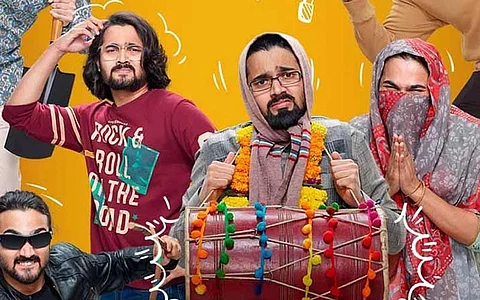
- Reviews
- Power List 2024
- Cannes 2024
- In-Depth Stories
- Web Stories
- News
- FC Lists
- Interviews
- Features
- FC SpecialsFC Specials

YouTube sketch comedian and singer-songwriter Bhuvan Bam's first web-show Dhindora is, unquestionably, a sensation. Having raked up over 20 million subscribers, he dropped eight weekly episodes on his channel, which unfailingly popped up among the most viewed shows of the week, shoulder to shoulder with juggernaut streaming releases of Amazon Prime Video, Disney+ Hotstar and Netflix. Two months after it premiered, the first episode has over 50 million views. A feat that feels all the more egregious given the context — Bhuvan Bam playing 10 characters, including himself, his father, his mother, his two friends, his maternal uncle, his father's colleague, a "Sasti Sherlock" who helps Bhuvan and his two friends crack a case, the don, and Bhuvan's college professor. That's ten, right?
This is not self-serving, frivolous content for his YouTube channel. It is serious television requiring a serious vision, unlike say Netflix's Aryan & Meera, which skates over the line between an advertisement and a web-show so recklessly, it eviscerates it. It isn't even like Dice Media and TVF's shows that have perfected the craft of feel-good television wrapped around a thick blanket of corporate sponsorship. Bhuvan Bam wants to be taken seriously at a craft level. The VFX on this show, requiring a team to stitch together five hours of shooting for a two-minute scene where three of the ten Bhuvan Bam's share screen space, announces this intention. (Bhuvan Bam breaks down this scene with Sucharita Tyagi here.) There are even long-takes — though it is suspect that in our cinematic climate, the one thing a filmmaker must do to signal craft and intention is to take a long take, a desperation for the efforts behind the scenes to be celebrated.
Bhuvan Bam has been working on these characters since 2017, lassoing them into one story with the help of writers Abbas Dalal and Hussain Dalal. The story itself is an excuse to melt these characters convincingly into something resembling a show. Some of these characters — like the college professor — are merely hi5s at Bam's own past YouTube videos and their sustained fanbase. They come and go, leaving the story unaffected.
Bhuvan's muffler-clad father wins the lottery, but before he is able to cash it in, he gets slammed by a car and loses his memory, all the while his wife has promised the entire neighborhood what she will do with the lottery money. The titular dhindora is being tooted by her. There are roving tracks of a gangster who is trying to get Bhuvan's uncle to return the money, Bhuvan falling in love with the intern who is looking after his father in the hospital, all the while Bhuvan and his two best friends are trying to uncover a conspiracy against his father. Then, there is also the business of the lottery. Did he actually win it? Will he actually get the money?
There are lines written keeping in mind the audience, knowing they will lap it up in one self-congratulatory burp. Sample this: "Hum middle class walon ki to aadat hoti hai na sapne pure hone se pehle jee lene ki."
Directed by debutante Himank Gaur, Dhindora is a restless piece of comedy, throwing jokes at the wall with a relentless pace — expletives, physical comedy, double entendre, even poetry (lodu or ludo ke beech, babhi ki nabhi chaatna …) — with a density that doesn't allow for breath. It's claustrophobically funny, demanding something out of you with every dialogue. Bam is able to get away with this because of the 20-minute episodes and the weekly drops. But I watched it in one 2.5 hour stretch and the effect was dizzying, dazzling, but also tiring. This is also because the humour is sweet, and not hilarious, often being unable to distinguish weird from funny. The world building is ridiculous, but the writing is often not able to trace the path from egregious to egregiously funny. In fact, I found Bam's physical comedy more compelling, more rib-tickling than the writing. He is dexterously able to inhabit a scene, holding each Dashavatar in its own body language. The talent is staggering, even if the writing is more self-serving than forward looking, happiest to hark back to past creations with thick winks at his fan base.
But Dhindora does something extraordinarily brave in the last two episodes — it asks, can comic caricatures elicit emotional responses? Bam sings an emotional song, and throws up a monologue (as in one character waxes eloquently, for Dhindora, if seen from one perspective, is essentially a Bhuvan Bam monologue). There are lines written keeping in mind the audience, knowing they will lap it up in one self-congratulatory burp. Sample this: "Hum middle class walon ki to aadat hoti hai na sapne pure hone se pehle jee lene ki." The line was quoted verbatim in the comments section with a fire emoji, and that whipped up 90,000 likes and counting. And maybe that is the problem. Bam is so certain of his audience, he is always writing towards them, never willing or able to shake them out of the fan-like stupor they are in. In the aforementioned chat with Sucharita Tyagi he noted the lacking female presence and how in the forthcoming seasons — and there will be forthcoming seasons — that will be corrected in front of and behind the camera. An acknowledgement that the status quo he is simmering in is not enough. That creation is only one half of craft. That the other is to challenge that very creation. Again and again.